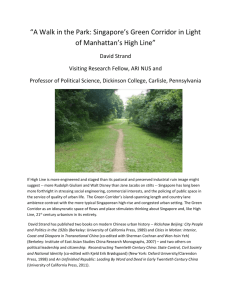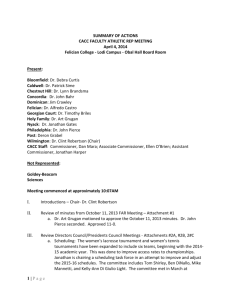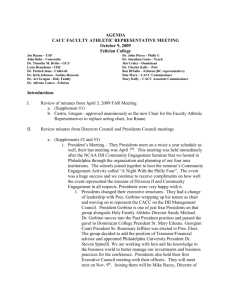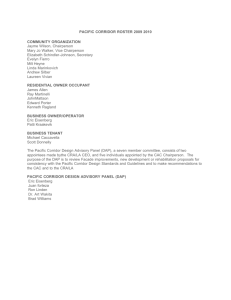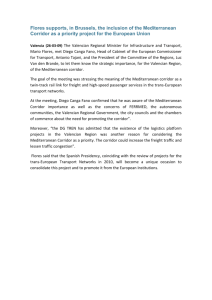October Work Group Notes - District Councils Collaborative
advertisement
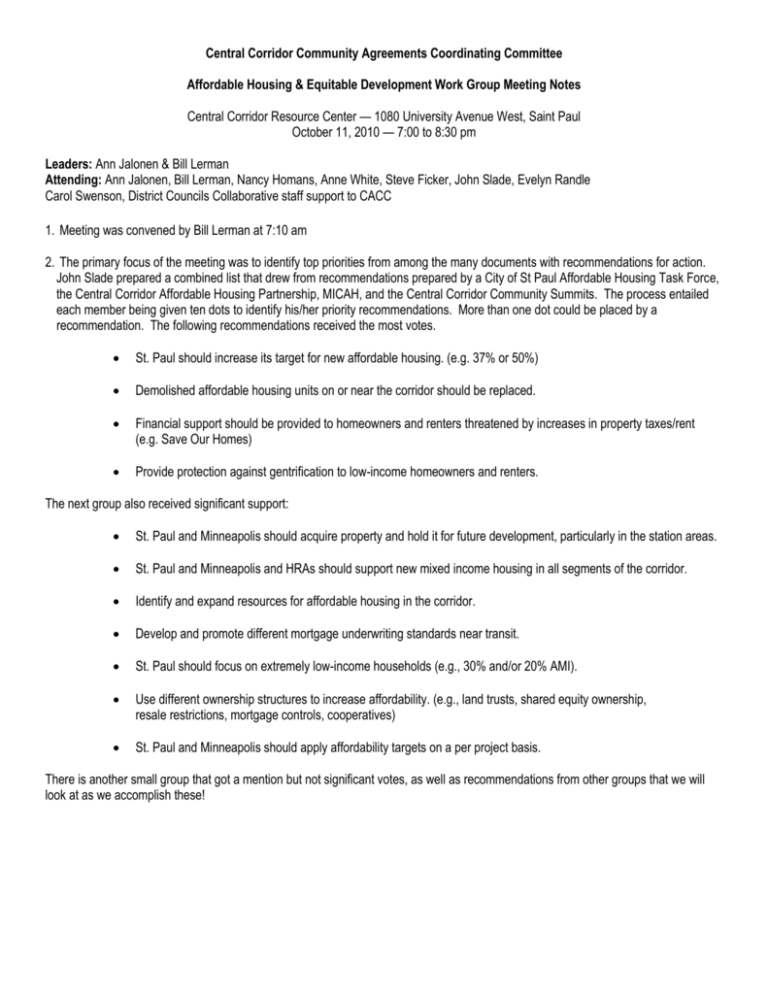
Central Corridor Community Agreements Coordinating Committee Affordable Housing & Equitable Development Work Group Meeting Notes Central Corridor Resource Center — 1080 University Avenue West, Saint Paul October 11, 2010 — 7:00 to 8:30 pm Leaders: Ann Jalonen & Bill Lerman Attending: Ann Jalonen, Bill Lerman, Nancy Homans, Anne White, Steve Ficker, John Slade, Evelyn Randle Carol Swenson, District Councils Collaborative staff support to CACC 1. Meeting was convened by Bill Lerman at 7:10 am 2. The primary focus of the meeting was to identify top priorities from among the many documents with recommendations for action. John Slade prepared a combined list that drew from recommendations prepared by a City of St Paul Affordable Housing Task Force, the Central Corridor Affordable Housing Partnership, MICAH, and the Central Corridor Community Summits. The process entailed each member being given ten dots to identify his/her priority recommendations. More than one dot could be placed by a recommendation. The following recommendations received the most votes. St. Paul should increase its target for new affordable housing. (e.g. 37% or 50%) Demolished affordable housing units on or near the corridor should be replaced. Financial support should be provided to homeowners and renters threatened by increases in property taxes/rent (e.g. Save Our Homes) Provide protection against gentrification to low-income homeowners and renters. The next group also received significant support: St. Paul and Minneapolis should acquire property and hold it for future development, particularly in the station areas. St. Paul and Minneapolis and HRAs should support new mixed income housing in all segments of the corridor. Identify and expand resources for affordable housing in the corridor. Develop and promote different mortgage underwriting standards near transit. St. Paul should focus on extremely low-income households (e.g., 30% and/or 20% AMI). Use different ownership structures to increase affordability. (e.g., land trusts, shared equity ownership, resale restrictions, mortgage controls, cooperatives) St. Paul and Minneapolis should apply affordability targets on a per project basis. There is another small group that got a mention but not significant votes, as well as recommendations from other groups that we will look at as we accomplish these! Central Corridor Community Agreements Coordinating Committee — LRT Construction Work Group Community Forum Planning Meeting Central Corridor Resource Center — 1080 University Avenue West, Saint Paul October 14, 2010 — 5:00 to 6:30 pm Leaders: Ann Jalonen and Rev. Joe Baring Attending: Phil Anderson, Vaughn Larry, Metric Giles, Jackie Cooper, Dennis Presley, Donna Evans – Carol Swenson and Karyssa Jackson, District Councils Collaborative staff support to CACC 3. Prior to the Work Group meeting, several Work Group members met with Marcus Harcus, organizer for HIRE Minnesota, a coalition of 70 organizations. Achieving and exceeding minority and women hiring goals for the CC Light Rail Project is one of their priorities. Lead organizations in the coalition are Summit Academy OIC, Alliance for Metropolitan Stability, and ISAIAH. They are interested in coordinating their efforts with the CACC LRT Construction Work Group. 4. Anne Jalonen convened the meeting. Everyone introduced themselves. Carol let everyone know that Rev. Baring called to let the committee know that an emergency came up and he would come to the meeting if possible. 5. The focal point of the meeting was determining whether or not we are ready to hold a Community Forum on Jobs this fall. o Work Group members shared what we have learned so far. Construction jobs will not be available in the numbers initially anticipated. Focus will need to be on generating jobs through economic development. Unions will give priority to getting people off the bench. Through various federal job programs there are nearly 800 job training slots now available in green construction. In preparing for future, there are a range of job opportunities and projects to consider: o Green jobs will be a focus. Green jobs entail a wide range of skills and types of jobs. o The corridor will continue to generate job opportunities outside the actual LRT project and into the future as development projects come forward, businesses locate in Central Corridor, and as the LRT line goes into operations. Union Depot is a good example…not only will renovation of the building generate jobs, but also its ongoing operation and maintenance. o The Work Group spent considerable time discussing barriers to jobs and training. Lack of knowledge about how unions work No driver’s license or an inactive license Drug testing Criminal record Inability to pass entry level math skills o We cannot do everything in one community meeting, there should be a series of meetings. 6. Community Forum this fall: o The Work Group felt it was possible to plan and hold a community jobs forum before Thanksgiving. (If this is not feasible, we agreed that the next opportunity is in early January.) o Forum Focus — given time is running out to train for jobs coming on line in March 2011, it seemed logical to focus this forum on training, overcoming the obstacles, and highlighting other short and long term job opportunities. o The Work Group identified the following potential speakers: Louis King, Summit Academy OIC; someone from Ramsey County Workforce Solutions; Wanda Kirkpatrick, Lucas Miller, or Roderick Southhall from the CC Project Office; and representatives from Walsh and/or Ames-McCrossan construction firms. o The Work Group identified a tentative date, time and location: Saturday, November 20; 10:00 am to 12:00 noon; Ober Community Center. 7. Next Steps o Create Training Opportunities Timeline o Ann offered to draft a forum concept paper and agenda for Work Group feedback. o Contact potential presenters o Initiate Logistics Plans Tentative Date o Attend October 21 Joint Disadvantaged Business Enterprise /Affirmative Action meeting with project contractors. Post Note: The October 21 DBE/AA drew several people. Construction contractors are still not achieving hiring goals. This raised serious questions and concerns from several agencies and organizations, especially with respect to those contracts nearing completion. This report was brought to the CACC Leadership Team. Community Agreements Coordinating Committee Neighborhood Livability and Transportation Equity Work Group Meeting Notes Central Corridor Resource Center • 1080 University Avenue West, Saint Paul Wednesday, October 13, 2010 • 5:00 to 6:15 pm Leaders: Anne White and Susan Larson-Fleming Attending: Anne White, Susan Larson-Fleming, Phil Anderson, Rev. Joe Baring, Rob Vanasek Karyssa Jackson & Carol Swenson, District Councils Collaborative staff support to CACC 1. Anne White convened the meeting. Susan Larson-Fleming facilitated the meeting. 2. Agenda — The group reviewed and approved as distributed. 3. Updates A. Susan reported on neighborhood identity o Legacy Grant for Arts and Culture has one more small grants round left. The deadline is October 29. The maximum amount is $7,000. This might be a source of funding to look at historic preservation opportunities in the corridor as a means for economic development and preservation of neighborhood identity. o Linda Pate, State Historic Preservation Office, Technical Advisor to the State Historic Tax Credits Program spoke at a recent meeting Susan attended. There is now more information available on the program. o PPERRIA is pursuing the concept of a Conservation District as an alternative option to city or national historic district designation for their neighborhood. Creation of a Conservation District designation/category would require an ordinance changes in Minneapolis and St Paul. Frogtown is considering the same option for an area within its boundaries. o On November 22, 7pm, Greg D’onofrio will be presenting at Prospect Park Methodist Church o There are plans for Prospect Park moratorium on construction until adequate planning and tools are in place to protect the neighborhood from encroaching development. o There was agreement among work group members that a small grant should be pursued if feasible and the DCC Governing Council is receptive. o Rob expressed his interest in continuing to track station naming. B. Safety and Access o Sidewalks are not being graded to be level with doorways on 4th Street in downtown Saint Paul. Carol will follow-up with Margot Imdieke-Cross and Project Outreach Coordinator Dana Happel to find out why that is. C. 2 vs. 4 lanes o Discussion of Traffic Study during construction: The work group discussed the pros and cons/validity of studying impacts of reducing University Avenue to one lane during construction. There was consensus that it would be beneficial to track traffic changes in the neighborhood street network during construction. At a minimum, a baseline traffic count is needed for comparison purposes during and after construction. o Rob reported that the St. Paul Northwest Area Study is moving forward. They are looking at 4 alternatives for crossing over the RR tracks. o Rob also reported that MnDOT is undertaking a traffic study of Snelling from I-94 to the border with Roseville. 4. Contingency Funds — The CACC charged the Neighborhood Livability and Transportation Equity Work Group to review how the community might prepare its list of priorities for use of Contingency Funds if and when they become available. (This would also include funding made available from construction bids coming in under budget.) With the caveat that the process for allocation of these funds is not clear and only those items approved by the FTA will be eligible, the work group developed a preliminary list for consideration: o Granary Road (Minneapolis & St Paul) — This potential road has been under discussion for a long time. Neighborhoods are not in complete agreement on the need and alignment. PPERRIA sees it as essential to improving safety for pedestrians and cars because it would offer an alternate route for trucks. If connected to the east, Saint Anthony Park Community Council sees it as a threat to residential neighborhoods; Marcy-Holmes is concerned that the southern connection would negatively impact housing proposed for the Mississippi River front. Work Group members discussed the potential for the CACC to bring Minneapolis and St Paul neighborhoods together to find a way forward that benefits everyone. o Streetscape Improvements — such as benches and trash receptacles as part of the project. o Improve accommodations for persons with disabilities o Improve the pedestrian environment on north-south streets to ensure safety and encourage people to walk to transit o Build more pedestrian bridges over I-94 to enhance connections o Bury overhead electrical lines on University Avenue in Minneapolis o Improve bus shelters and ensure snow removal o Improve pedestrian lighting Next Steps: Next Meeting Scheduled November 17, 5pm Central Corridor Community Agreements Coordinating Committee Leadership Team Meeting Notes October 22, 2010 • 12:00 noon • Golden’s Deli • Lowertown, Saint Paul Present: Chris Ferguson, Metric Giles, Cam Gordon, Vaughn Larry, Chamath Perera, Anne White; Karyssa Jackson and Carol Swenson, District Councils Collaborative and staff to CACC 1. Convene Meeting and Assign Facilitator: Chamath Perera facilitated the meeting. 2. Review Agenda: Given time constraints, the team agreed to address the Nov. 1 CACC agenda first, then governance issues, and finally the Community Forum on Jobs. 3. November 1 CACC Agenda a. Small Business Marketing Plan — Chris described the “Loyalty Card” program being developed. This is part of a larger “Discover Central Corridor” marketing campaign being developed under the auspices of the Business Resources Collaborative. (The Midway Chamber is heading up the branding and grassroots marketing components of the campaign.) The Loyalty Card program is design to help businesses collect baseline customer information prior to construction and to track customer activity during and after construction. Nonprofits can benefit from the program by distributing cards to their constituents. When their constituents use the card, businesses donate a percentage of the sale to the nonprofit that sponsored the card. The BRC would like to do a soft launch of the program in early November and a major launch and promotion in early December. The BRC is still seeking funding to cover or buy down upfront costs to produce the Loyalty Card, which would help out small businesses and nonprofits. Chris would like to present the concept and program outline to the CACC on November 1 and seek CACC endorsement of the program. Ins return, the CACC would get recognition for supporting the program. He would like feedback from CACC members about the general concept of the program and the nonprofit component. The Leadership Team was receptive to having Chris present and allowing time for discussion (at least 30 minutes). Chris was asked to prepare an outline of the program and requested CACC action for circulation with the November 1 Agenda and Packet, which will be email on October 25. b. Disadvantaged Business Enterprises/Affirmative Action Presentation — Jackie Cooper, aide to Commissioner Carter has contacted Wanda Kirkpatrick, Met Council Director of the Office of Diversity and Equal Opportunity, about a presentation of the DBE/AA Program for Central Corridor to the CACC. Several members of the Leadership Team attended the October 21 Joint DBE/AA meeting for Central Corridor. (This is monthly meeting with contractors to review performance on contracting and hiring goals.) At the October meeting, Bolander reported that it had not met its goals; Graham reported that many of its sub-contractors were not meeting their goals; and Walsh was apparently not prepared for the meeting. This situation raised many questions and concerns about non-compliance and consequences, program regulations and reporting, Union situations and how that influences the hiring process, etc. The Leadership Team was in agreement that it is timely to invite Ms. Kirkpatrick to make a presentation and field questions from the full CACC. The Team also agreed that Louis King with Summit OIC should be invited to attend and talk about the reporting form he has developed, his past experiences with getting people into training and placing them in jobs, etc. (Mr. King is also affiliated with the HIRE Minnesota campaign and can talk about their work.) The item should be given 30 minutes on the agenda. 4. CACC Goals for next 6 months and the Role of the Leadership Team a. The Leadership Team agreed to make this item a priority for the next meeting. 5. Update on Community Forum on Jobs — Saturday, November 20 at 10 am is the tentative date and time for the forum. The LRT Construction and Community Engagement Work Groups are finalizing the format, speakers, and agenda. 6. Governance Tasks Review of Governance Guidelines — Anne White will review the document and circulate draft revisions for comments from the Leadership Team. b. Regular meeting — Carol/Karyssa will circulate an email to team members to identify a regular meeting time. November may be difficult with Thanksgiving occurring the third week when it would be best to meet. c. Filling vacant seats on the CACC — We now have two – three seats that are not filled with active participants. The Leadership Team will take up this issue via email. a. Meeting adjourned at 1:45 pm.


